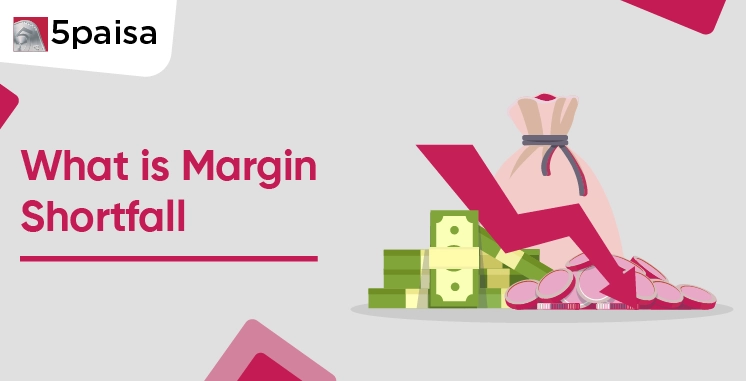Content
Margin shortfall refers to the situation when a trader’s account balance falls below the minimum margin required to maintain open positions in the stock or derivatives market. This is especially common in leveraged trading, where brokers and exchanges require traders to hold sufficient funds or securities as a cushion against potential losses.
Failing to meet this requirement leads to a margin shortfall, which can result in penalties, margin calls, or forced position closures. To trade safely and cost-effectively, it's critical to understand what is margin shortfall, how it works, and how to avoid margin shortfall through disciplined risk management.
Unlock the full article - sign in with Gmail!
Expand Your Market Knowledge with 5paisa Articles
How Does Margin Shortfall Happen in Trading?
A margin shortfall typically arises when your account doesn’t have enough funds or approved collateral to meet the margin requirements set by the broker or exchange. This can occur due to:
- Adverse price movements against your open positions.
- Increased volatility leading to a sudden hike in margin requirements.
- Delay in adding funds after a margin call.
- Margin blocked across multiple positions, reducing available balance.
For instance, if your position requires ₹1,50,000 in margin but your account has only ₹1,20,000, there is a margin shortfall of ₹30,000. This difference is referred to as a margin shortfall, and brokers are required to act on it to limit risk exposure.
Understanding Margin Requirements
To fully grasp the concept of margin shortfall, it helps to understand the types of margins in trading:
- Initial Margin: Required to initiate a trade.
- Maintenance Margin: The minimum amount needed to keep a position open.
- SPAN Margin: Calculated using a risk-based algorithm for derivatives.
- Exposure Margin: An additional buffer mandated by the exchange to cover potential volatility.
These margin levels are not fixed and may change depending on market conditions. If your account doesn't adjust to these changes in real-time, you're at risk of a margin shortfall.
What Happens When You Face a Margin Shortfall?
If your margin falls short, your broker or the exchange will initiate a series of actions to protect against further losses:
- Margin Call: A prompt to add cash or approved securities to cover the shortfall.
- Penalty Charges: A daily margin penalty may be imposed until the shortfall is resolved.
- Auto Square-Off: Open positions might be squared off to limit further risk.
- Trading Restrictions: You may be temporarily restricted from placing new trades.
Dealing with a margin shortfall quickly can help avoid penalties and forced exits from potentially profitable trades.
Margin Penalty: How Much Can It Cost You?
The margin penalty for a shortfall is regulated by SEBI and the exchanges. It varies based on the amount and frequency of the shortfall.
Typical rates include:
- 0.5% of the shortfall amount for minor or first-time breaches.
- 1% of the shortfall amount for larger or repeat instances.
- These penalties can apply per day until the margin shortfall is resolved.
Even a single day of delayed response can lead to avoidable charges and reduce your overall profitability.
How is the Margin Penalty Calculated?
The margin penalty is calculated by the clearing corporation based on:
- The size of the margin shortfall.
- Whether the shortfall is in SPAN margin, exposure margin, or both.
- Duration and frequency of the violation.
Example: If the required margin is ₹2,00,000 and your available margin is ₹1,60,000, the shortfall is ₹40,000. If it's your first violation, the penalty might be ₹200 (0.5%). Repeat violations or larger shortfalls may attract higher penalties.
Understanding these calculations helps you appreciate why it's important to monitor your margin status constantly and avoid margin shortfall.
Margin Shortfall Charges by Brokers
While penalties are imposed by the clearing corporation, brokers may also add:
- Exchange-imposed penalty pass-throughs.
- Administrative fees or GST on penalty amounts.
- Interest on delayed payments for resolving margin shortfalls.
Brokers may notify you via SMS, app alerts, or email if your margin balance is falling short. But it's your responsibility to act quickly to avoid accumulating margin penalty charges.
How to Avoid Margin Shortfall?
Knowing how to avoid margin shortfall can save you money and stress. Here are actionable steps to reduce the chances of a shortfall:
- Maintain a buffer above the minimum required margin.
- Monitor your account balance and MTM losses frequently.
- React to margin calls immediately to prevent position squaring off.
- Use proper stop-loss orders to limit potential downside.
- Avoid overleveraging or taking trades you cannot comfortably fund.
- Keep track of multiple positions, which might block more margin than you expect.
Being proactive and conservative in your margin usage is the best way to avoid margin shortfall and stay compliant.
Common Causes of Margin Shortfall
Here are some frequently observed triggers for margin shortfall:
- High market volatility causes a sudden spike in margin requirements.
- Delayed fund transfers, especially outside banking hours.
- Multiple positions leading to underestimated margin exposure.
- Changes in exchange margin rules overnight or during volatile conditions.
- Non-pledged securities not counted as margin collateral.
Many of these issues can be mitigated by using margin calculators and staying updated with broker/exchange notifications.
Conclusion
Understanding what is margin shortfall, its causes, and its consequences is vital for anyone involved in derivatives or margin trading. Not only does it help you stay compliant with trading rules, but it also protects your capital and future opportunities. With the right practices and awareness, you can reduce the likelihood of encountering a margin shortfall and avoid unnecessary margin penalty charges.



